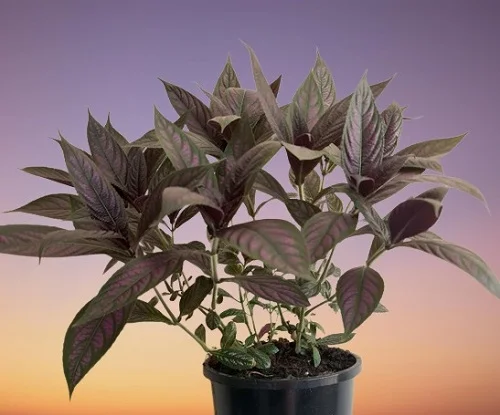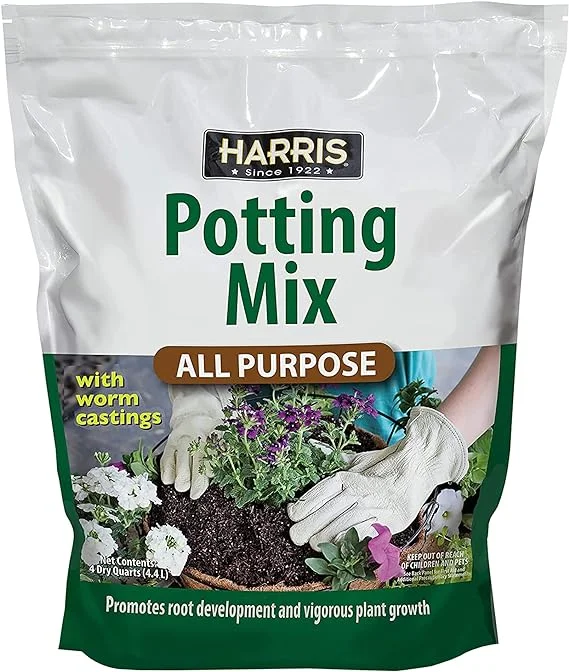How to Grow and Care for Persian Shield Plant (Strobilanthes dyerianus) Indoors
Some links in this post may be affiliate links
Persian Shield Plant (Strobilanthes dyerianus) blossoms in bright indirect light, warm and humid conditions and consistently moist, rich, well-drained soil coupled with fortnightly feeding in the growing season.
Persian Shield Plant also called Royal Purple Plant or Bermuda Conehead is one of the popular purple-leaved plants as it bears finely-toothed dark-green foliage with bright, metallic-purple stripes radiating outward from the central leaf vein.
Royal Purple Plant is an erect, evergreen shrub whose purplish foliage declines with age. The old plants are straggly, the color fades and the foliage becomes silvery with dark veins. At this stage discard the old plants and replace with new plants which you may propagate from stem-tips cuttings.
The common name, 'Persian Shield', is in reference to the leaves which resemble feudal battle shields.

Botanical name: Strobilanthes dyerianus
Family: Acanthaceae
Common names: Persian Shield Plant, Royal Purple Plant, Bermuda Conehead
Origin
Strobilanthes dyerianus is native to Myanmar. The species name "dyerianus" is in honour to the English botanist Sir William Turner Thiselton-Dyer (1843-1928).
Toxicity
Persian Shield Plant is mildly toxic to humans and pets. If ingested, the plant sap can cause burning in the mouth, tongue and throat. Keep the plant away from children and pets to avoid any mishaps.
Where to Buy
If you are looking to add Royal Purple Plant to your collection, check them out on Etsy (Link to Etsy).
Strobilanthes dyerianus Care Indoors
Persian Shield Plant (Strobilanthes dyerianus) flourishes in bright indirect light, average warmth of 18-240C, humidity of 50-60% and consistently moist, fertile, well-drained, all purpose potting soil coupled with fortnightly feeding during the growing season.
Strobilanthes dyerianus requires regular pruning to keep it neat, to encourage a bushy growth and to rejuvenate growth. Young plants require annual repotting but mature plants are repotted when pot-bound. Keep reading for more on these growing conditions and how to achieve them.

Light Requirements
Persian Shield Plant grows best in bright indirect light to maintain the leaf color. Keep it away from direct sunshine as it can lead to scorching of the leaves.
Inadequate light will lead to a thin and leggy plant therefore, consider investing in grow light if the natural lighting is insufficient. Check out these full spectrum grow lights on Amazon.
Rotate the pot regularly to ensure that the plant receives light on all sides for uniform growth and prevent lopsided growth.
Watering
Water Persian Shield Plant thoroughly during the growing season to keep the soil consistently moist while allowing the top 1-2 inches of soil to dry out between waterings.
Cut down on watering during the cold season to keep the soil slightly moist as growth is minimal at this time. Do not allow the soil to dry out completely.
Ensure the pot has a drainage hole to prevent the soil from getting soggy as it can lead in root-rot and loss of the plant.
Temperature and Humidity
Average warmth of 18-240C is ideal for Persian Shield Plant. Keep it away from drafts to prevent sudden changes in temperature which can result in reduced growth and shrivelled leaves.
Persian Shield Plant thrives in a humidity of 50-60%. Low humidity will result in brown, crispy leaf tips and edges. Set the pot on a wet pebble tray or use a cool mist humidifier to increase humidity.
Clean the leaves regularly by damp-wiping with a soft cloth to keep them clean and neat as well as discourage pest and disease infestations. Ascertain that there is proper circulation to discourage fungal diseases.
Fertilizer
Feed Persian Shield Plant every 2 weeks during the growing period with a balanced, liquid fertilizer but do not feed in the cold season as growth is minimal and feeding at this time may lead to fertilizer burn.
Occasionally, flush out accumulated salts (which may have arisen from the water or fertilizers) from the soil by running for a few minutes a steady stream of water through the soil until it comes out through the drainage holes. Repeat the process several times.
Potting Mix
The best soil for Persian Shield Plant should be rich in organic matter and free-draining to prevent it from getting soggy while providing the required nutrients. All purpose potting mixes are ideal.
Repotting
Repot the young Persian Shield Plant annually at the beginning of the growing season. The mature plants need to be repotted when they become pot-bound. Use a pot one size larger than the current one. Make sure that the pot has a drainage hole to prevent the soil from getting soggy as it can lead to root-rot. Take a look at these pots with drainage holes on Amazon.
Pruning
Pruning Persian Shield Plant involves regular removal of dead foliage to maintain the plant neat and discourage pest and disease infestations. To control the height of the plant and encourage bushyness, pinch the growing tips.
Propagation
Persian Shield Plant (Strobilanthes dyerianus) propagation is done during the growing period from stem-tip cuttings.
How to Propagate Persian Shield Plant from Stem-tip Cuttings
The Persian Shield Plant stem cuttings root easily so there is no need for rooting hormone.
Take a stem cutting of about 3-5 inches from a healthy Persian Shield and ensure it bears at least two sets of leaves.
Insert the cutting in moist free-draining soil and place in a warm, well-lit place.
Maintain the soil moist through out until new growth emerges on the cutting.
Allow the new Strobilanthes dyerianus to be well established before transplanting after which you can begin routine care.

Strobilanthes dyerianus Growing Problems
Persian Shield Plant (Strobilanthes dyerianus) problems include dull leaves, shrivelled leaves, leaf spots, leggy growth, pests and diseases. Read on for more on these problems, their remedies and solutions.
Pests
Common pests in Persian Shield Plant are spider mites, fungus gnats, aphids and whiteflies. Isolate the affected plant to prevent spread to other plants and treat it with neem oil or insecticidal soap. Ensure to follow the manufacturer's instructions.
Diseases
The most common disease in Persian Shield Plant is root-rot which is promoted by soggy soil. Make sure that the pot has a drainage hole to prevent the soil from getting soggy. Read more on how to treat root-rot in houseplants.
Leggy growth
All the stems become leggy with age therefore replace a leggy plant with a young vibrant plant. However, there are three possible causes of leggy growth in Persian Shield Plant. One possible cause is too little light.
Position the plant to a brighter spot where it will receive bright indirect light or instal a grow light if the natural light is insufficient. Check out this post on understanding light for houseplants.
The second possible cause of leggy growth in Persian Shield Plant is too little water (underwatering). Maintain the soil moist at all times during the growing season while allowing the top 1-2 inches of soil to dry out between waterings. Never allow the soil ball to dry out completely. Learn more on how to water houseplants the right way.
The third possible cause of leggy growth in Persian Shield Plant is inadequate feeding. Feed the plant every 2 weeks during the growing season with a balanced, liquid fertilizer. Do not feed in the growing season as growth is less at this time and feeding may cause fertilizer burn. Learn how to feed houseplants.
Brown, shrivelled leaf tips
Brown, shrivelled leaf tips in Persian Shield Plant is too low humidity. To elevate humidity, set the pot on a wet pebble tray or use a cool mist humidifier. Check out these techniques on how to increase humidity for houseplants.
Dull leaves
Dull leaves in Persian Shield Plant are caused by inadequate light (too low light). The development of the beautiful purple sheen on the leaves requires adequate light. Move the plant to a brighter spot where it will receive bright indirect light or instal grow lights if the natural light is inadequate.
Spotted leaves
Spotted leaves in Persian Shield Plant is caused by cold water droplets falling on the leaves during watering. Avoid wetting the leaves when watering or water from the bottom instead.
You liked it? Share on social media.
Related Content
Amazon Associates Disclosure
Homeplantsguide.com is a participant in the Amazon Services LLC Associates Program, an affiliate advertising program designed to provide a means for sites to earn advertising fees by advertising and linking to amazon.com.





